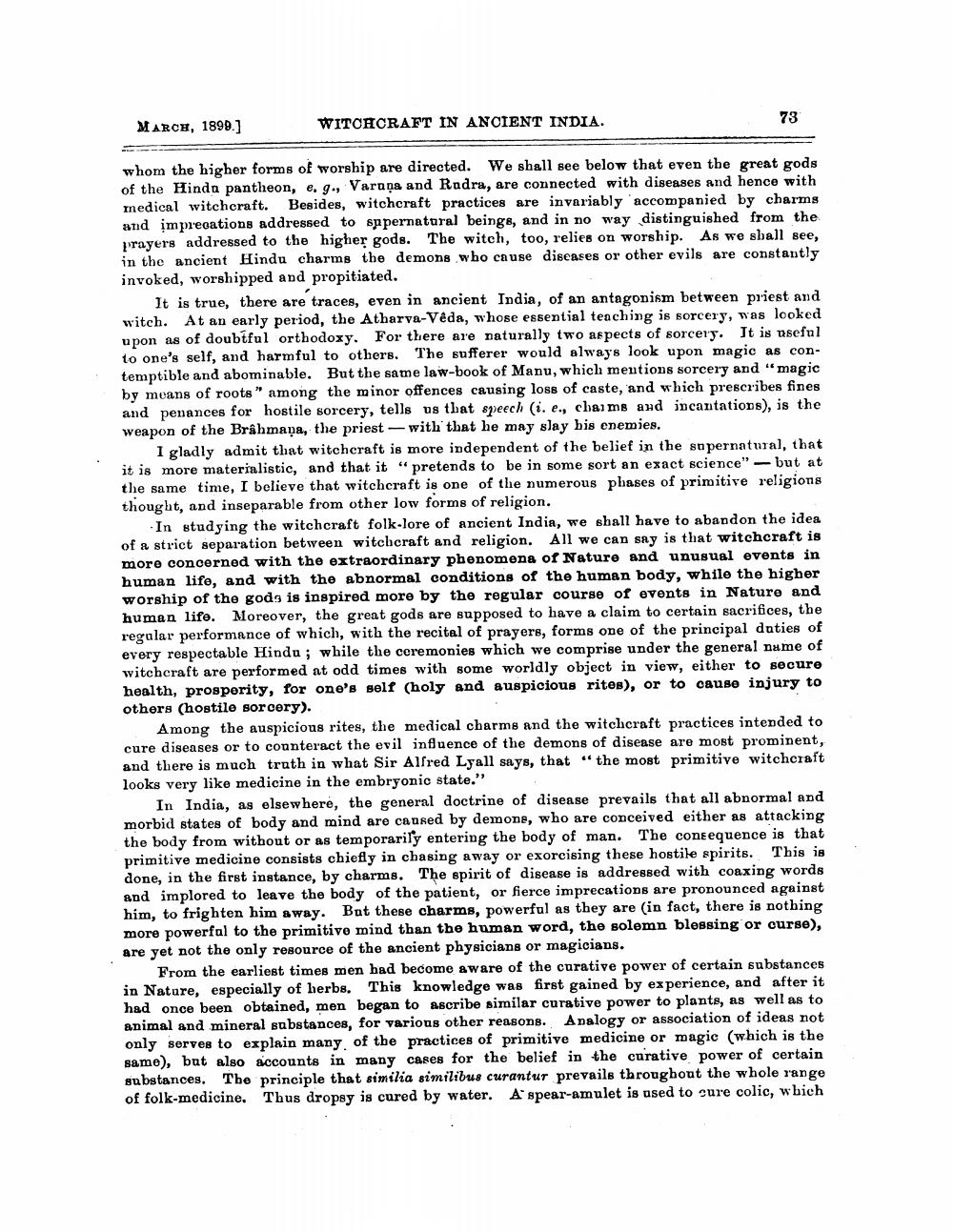________________
WITCHCRAFT IN ANCIENT INDIA.
73
MARCH, 1899.]
whom the higher forms of worship are directed. We shall see below that even the great gods of the Hindu pantheon, e. g., Varuna and Rudra, are connected with diseases and hence with medical witchcraft. Besides, witchcraft practices are invariably accompanied by charms and imprecations addressed to sppernatural beings, and in no way distinguished from the prayers addressed to the higher gods. The witch, too, relies on worship. As we shall see, in the ancient Hindu charms the demons who cause diseases or other evils are constantly invoked, worshipped and propitiated.
It is true, there are traces, even in ancient India, of an antagonism between priest and witch. At an early period, the Atharva-Vêda, whose essential teaching is sorcery, was looked upon as of doubtful orthodoxy. For there are naturally two aspects of sorcery. It is useful to one's self, and harmful to others. The sufferer would always look upon magic as contemptible and abominable. But the same law-book of Manu, which mentions sorcery and "magic by means of roots" among the minor offences causing loss of caste, and which prescribes fines and penances for hostile sorcery, tells us that speech (i. e., charms and incantations), is the weapon of the Brahmana, the priest - with that he may slay his enemies.
I gladly admit that witchcraft is more independent of the belief in the supernatural, that it is more materialistic, and that it "pretends to be in some sort an exact science" but at the same time, I believe that witchcraft is one of the numerous phases of primitive religions thought, and inseparable from other low forms of religion.
In studying the witchcraft folk-lore of ancient India, we shall have to abandon the idea of a strict separation between witchcraft and religion. All we can say is that witchcraft is more concerned with the extraordinary phenomena of Nature and unusual events in human life, and with the abnormal conditions of the human body, while the higher worship of the gods is inspired more by the regular course of events in Nature and human life. Moreover, the great gods are supposed to have a claim to certain sacrifices, the regular performance of which, with the recital of prayers, forms one of the principal duties of every respectable Hindu; while the ceremonies which we comprise under the general name of witchcraft are performed at odd times with some worldly object in view, either to secure health, prosperity, for one's self (holy and auspicious rites), or to cause injury to others (hostile sorcery).
Among the auspicious rites, the medical charms and the witchcraft practices intended to cure diseases or to counteract the evil influence of the demons of disease are most prominent, and there is much truth in what Sir Alfred Lyall says, that "the most primitive witchcraft looks very like medicine in the embryonic state."
In India, as elsewhere, the general doctrine of disease prevails that all abnormal and morbid states of body and mind are caused by demons, who are conceived either as attacking the body from without or as temporarily entering the body of man. The consequence is that primitive medicine consists chiefly in chasing away or exorcising these hostile spirits. This is done, in the first instance, by charms. The spirit of disease is addressed with coaxing words and implored to leave the body of the patient, or fierce imprecations are pronounced against him, to frighten him away. But these charms, powerful as they are (in fact, there is nothing more powerful to the primitive mind than the human word, the solemn blessing or curse), are yet not the only resource of the ancient physicians or magicians.
From the earliest times men had become aware of the curative power of certain substances in Nature, especially of herbs. This knowledge was first gained by experience, and after it had once been obtained, men began to ascribe similar curative power to plants, as well as to animal and mineral substances, for various other reasons. Analogy or association of ideas not only serves to explain many of the practices of primitive medicine or magic (which is the same), but also accounts in many cases for the belief in the curative power of certain substances. The principle that similia similibus curantur prevails throughout the whole range of folk-medicine. Thus dropsy is cured by water. A spear-amulet is used to cure colic, which




